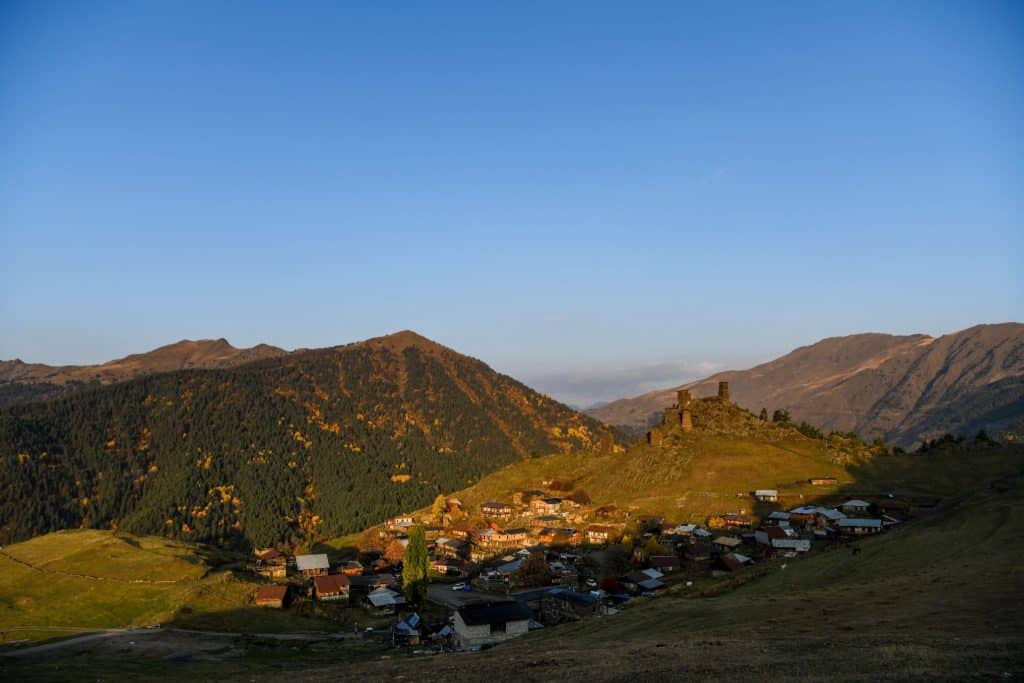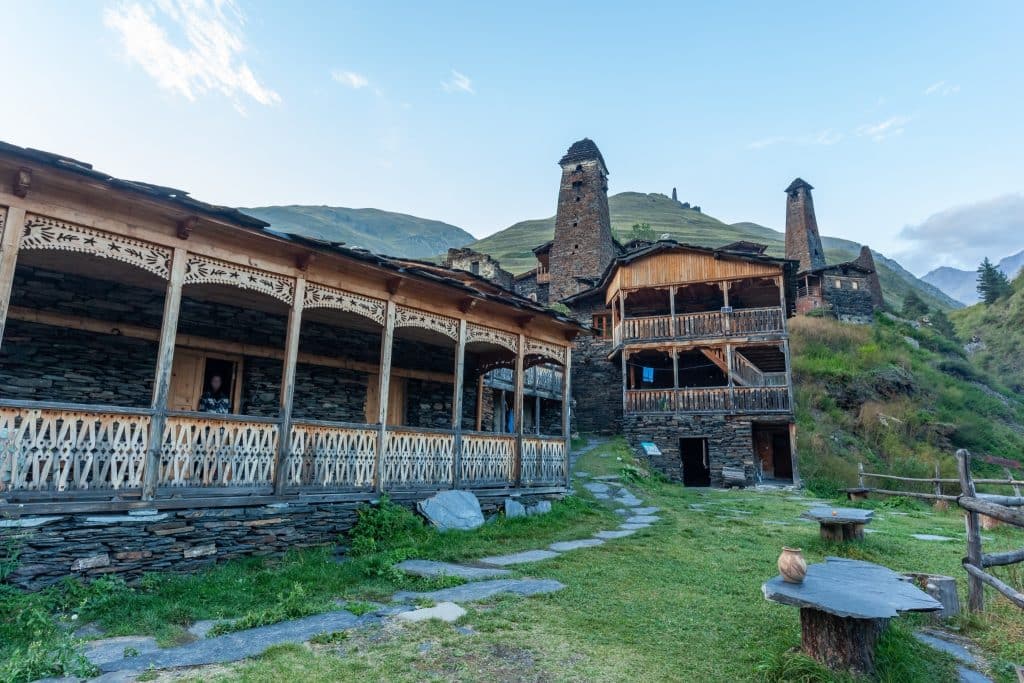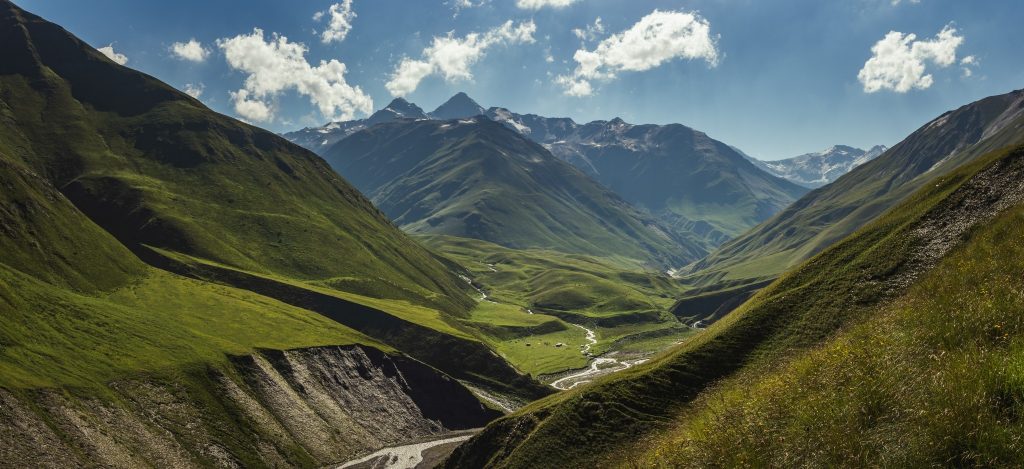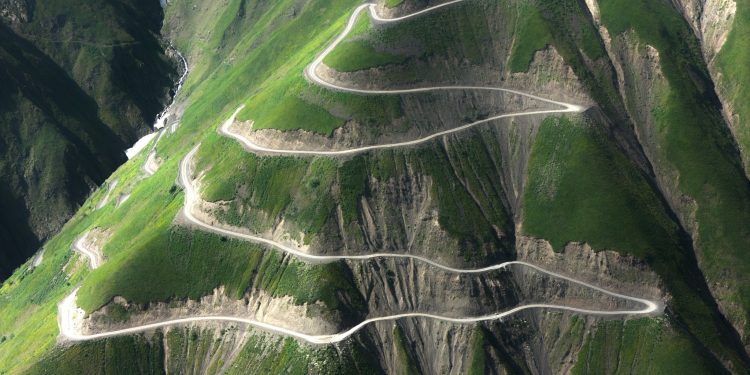You feel it the moment the road leaves the vineyards and starts climbing: Tusheti National Park is a different Georgia. The switchbacks crawl toward Abano Pass and the air turns sharp, the Caucasus runs like a stone spine ahead of you. Ancient towers appear on ridges, horses graze along cold streams, and the villages cling to green slopes. If you’re chasing raw landscapes, old pathways, and trails scented with wild thyme, Tusheti National Park grips you early and doesn’t let go. This simple, practical guide helps you plan fast, ride safely, and see the heart of Tusheti National Park without rushing.
Omalo Gateway: Where the Road Ends and Trails Begin
The final approach to Tusheti National Park feels like a rite of passage. The road tops Abano Pass and drops into a high world of meadows and slate-black ridges. Omalo is the gateway, split into Lower Omalo and Upper Omalo (Keselo). From here, footpaths and horse trails run toward Dartlo, Shenako, Jvarboseli, and the Alazani headwaters. The scale is big, but your time doesn’t have to be. Even three days inside Tusheti National Park gives you towers, shepherd paths, and that soft gold evening light across alpine hills. If you’re traveling lean, browse On a Budget and match Tusheti National Park routes with low-cost stays and simple meals.
Abano Pass Reality Check: Road, Weather, Nerves
Abano is the psychological gate to Tusheti National Park—steep, narrow, exposed, and moody when weather turns. Snow can linger in early summer and return late in the season. Drivers go slow, pause to cool brakes, and treat blind corners with courtesy. If the forecast looks unstable, shift your plan by a day. In Tusheti National Park, patience with the sky is the best safety habit. Pack a warm layer, rain shell, gloves, and a headlamp. Hiring a local driver helps: high-clearance vehicles handle the ruts and mud. Sit on the uphill side if exposure bothers you; early crossings are calmer and often clearer on the way to Tusheti National Park.
Dartlo Watchtowers: Why the Stones Still Matter
Stone towers define Tusheti National Park. In Dartlo, they stand in tight clusters, turning the hamlet into a silhouette of teeth against the sky. Once signal posts and defense, they now anchor the landscape. Hike between villages and the towers guide you like lighthouses. Some are restored, some lean, all tell the story of Tusheti National Park. Spend a night near a tower and watch the light change minute by minute. For small time-savers—packing tweaks, route sequencing, and weather pivots—skim Travel Hacks before you set out in Tusheti National Park.
Classic Horse Trails in Tusheti National Park
Riding is daily life here, and the best miles in Tusheti National Park still carry hoofprints. Outfitters in Omalo and Dartlo pair beginners with calm horses for valley loops, or guide experienced riders on multi-day traverses. The Pirikiti Alazani valley has gentler grades and long sightlines; Gometsari is steeper and quieter. Trails are clear, river crossings common, and lunches simple: bread, cheese, cured meat on a warm rock. Guides read the cloud language of Tusheti National Park and reroute before storms. Ask about saddle fit, daily distance, and water stops—small details make big differences across Tusheti National Park.
Simple Loops for First-Timers
If it’s your first time in Tusheti National Park, keep plans tight and days flexible.
Omalo – Dartlo – Omalo (1–2 days): A perfect starter. Walk or ride the valley, wander Dartlo’s lanes, and return. You get towers, river sound, and village life without committing to a long traverse. The rhythm of Tusheti National Park becomes clear on this loop.
Omalo – Shenako – Diklo (1–2 days): A gentler line with views toward Dagestan. Sleep in Shenako or Diklo for sunrise on the ridge. Culture and high country braid together in Tusheti National Park.
Atsunta Pass Traverse (3–4 days, experienced): Cross the spine to Khevsureti. Variable weather, early/late snow patches, long gaps between villages—this is the wilder edge of Tusheti National Park.
When to Go and How to Think About Weather
The season in Tusheti National Park is short—late June to mid-September for most visitors. Snow can sit on high passes into July. August is the most stable and the busiest. September brings crisp air, quiet trails, and clear light. Nights are cold all season. Showers pass quickly, but a stalled system can lock valleys in cloud. Build one buffer day. In Tusheti National Park, timing and patience beat any gear list.

Choosing Your Base: Omalo, Dartlo, or Shenako
All three work as hubs inside Tusheti National Park. Omalo has the most guesthouses and services, with Upper Omalo’s towers steps away. Dartlo is smaller and photogenic, perfect for up-and-down loops in Pirikiti. Shenako sits in open meadow with big views and a beautiful small church. Pick the mood you want, then refine your plan. For broader inspiration beyond Tusheti National Park—big landscapes with human scale—browse Epic Destinations and come back ready to focus.
Packing Smart for Tusheti National Park
Think light, tough, weather-ready. A 35–45L pack suits hut-to-hut days in Tusheti National Park. Add a compact down jacket, rain shell, fleece, merino base, sun hat, gloves, sunglasses, and sunscreen. Trail runners with grip handle summer paths; waterproof boots help in shoulder season and on river days.
Trekking poles save knees on long descents in Tusheti National Park. Carry a filter bottle, small first-aid kit, blister care, tape, a few zip ties, and a repair mini-kit. Offline maps plus a printed map give redundancy. A headlamp is non-negotiable; clouds drop fast in Tusheti National Park.
Food, Water, and the Taste of the High Country
Guesthouses across Tusheti National Park serve filling meals: khachapuri, khinkali, grilled meats, mountain herbs, and strong tea. Breakfasts are hearty; lunches can be packed or cooked if you return. For snacks, carry nuts, dried fruit, and chocolate. Springs are common, but filter when unsure. Ask hosts about local cheeses and seasonal condiments; small flavors tell the story of Tusheti National Park as clearly as any skyline. If you’ll be remote, confirm refills and bridge status before leaving.
Respect for Place: Culture and Courtesy
Tusheti National Park is living culture, not a backdrop. Dress modestly in villages, especially near churches or tower precincts. Ask before photographing people. Stay on paths through fields.
Don’t climb fragile towers or disturb stones. Keep voices low at night. Accept tea invitations with thanks and simple conversation. These courtesies make travel smoother in Tusheti National Park and keep welcome strong for those who follow.
Three Easy Day Hikes to Learn the Land
Omalo to Upper Omalo Towers (Keselo): Short, rewarding, and the fastest sketch of Tusheti National Park—history, towers, and a wide view in under two hours.
Dartlo to Kvavlo Ridge: Steady climb to restored towers and a Pirikiti panorama. A picnic here teaches how Tusheti National Park stacks meadow, forest, and stone.
Shenako to Diklo: Gentle rolling path, frontier views, quiet church. Sunrise or late light turns the scene soft. A calm side of Tusheti National Park.
Multi-Day Ideas When You Have Time
Pirikiti Valley String (3 days): Omalo – Dartlo – Dano – Chesho – Omalo. Easy grades, river soundtracks, classic towers—an unhurried lesson in the daily rhythm of Tusheti National Park.
Gometsari Traverse (3–4 days): Omalo – Jvarboseli – Iliurta – Vestmo. Steeper, wilder, quieter. You’ll spend long hours alone with the hills of Tusheti National Park.
Atsunta to Khevsureti (4 days, experienced): Big crossing, early/late snow risk, weather windows required. From the crest, space feels endless—Tusheti National Park behind, another high valley ahead.

Low-Impact Travel in a High Country
Leave no trace keeps Tusheti National Park wild. Pack out trash, use toilets, keep soap out of streams, and stay on paths to protect fragile turf. If a section is muddy, go through it rather than widening the trail. Close gates after passing. Keep music for the room, not the ridge, small choices multiply across many boots and hooves.
Staying Connected (Or Not)
Signal is patchy across Tusheti National Park and often absent on trails. Tell your host your plan and ETA. If you work on the road, cluster tasks around evening windows in Omalo or Dartlo. For mixing trails with remote work beyond Tusheti National Park, tap Digital Nomad resources and build in connectivity days so the mountains stay restful.
Budget, Cash, and Card Reality
Guesthouses across the region are usually cash-based. ATMs sit down-valley, not on the plateau. Carry enough for nights, meals, rides, and a weather buffer. Prices are fair but rise with remoteness. To stretch funds and add a day up high, revisit On a Budget and pick swaps that matter most—shared transfers, simpler rooms, self-catered lunches.
Sample Three-Day Plan (With Weather Flex)
Day 1: Cross Abano, settle in Omalo, wander to Upper Omalo towers, watch sunset. Your first easy taste of the highlands.
Day 2: Early ride or hike to Dartlo, lunch on the stones, optional Kvavlo ridge, return. If clouds thicken, skip the ridge and enjoy village time. A full mountain day either way.
Day 3: Shenako–Diklo loop, wide views and quiet church, back to Omalo. If weather blocks one loop, swap days. Safety and simple joy lead the way.
Extending the Trip: Add a Pass Day
With a good forecast and one more day, add Nakaicho or a high shoulder above Pirikiti. Choose a climb that buys a clean horizon and an unhurried descent. The memory that lasts is usually a long view and a quiet hour.
Getting There and Away Without Drama
From Tbilisi, most travelers reach Telavi, then hire a sturdy vehicle for Abano. Start early to beat afternoon weather and outbound traffic. If you need a reset day before entering the high country, base in Telavi. Confirm return plans but keep them soft; weather holds the pass when it wants. If you’re mixing work and trail days, the Digital Nomad checklists adapt easily to local timing and tools.

One More Resource for Route Ideas
Before you lock distances, browse Travel Hacks for packing lists and weather pivots. Then ask your guesthouse for trail conditions in the area; local knowledge beats any winter blog post.
Your Map Forward
Travel stays simple when you break it into small, reliable steps: a safe road day, a friendly bed, a path that suits your legs, and a weather window that lets the hills speak. Do those four, and the rest follows. For planning beyond this region, keep the main hub handy Viral Voyage so you can jump from idea to itinerary without losing the thread.



